Modern industries are flooded with material choices—but choosing the wrong one can cost you time, money, and your reputation.
Woven, non-woven, and paper materials1 each have unique properties, uses, and sustainability levels2. Understanding their differences helps buyers make better sourcing decisions3.
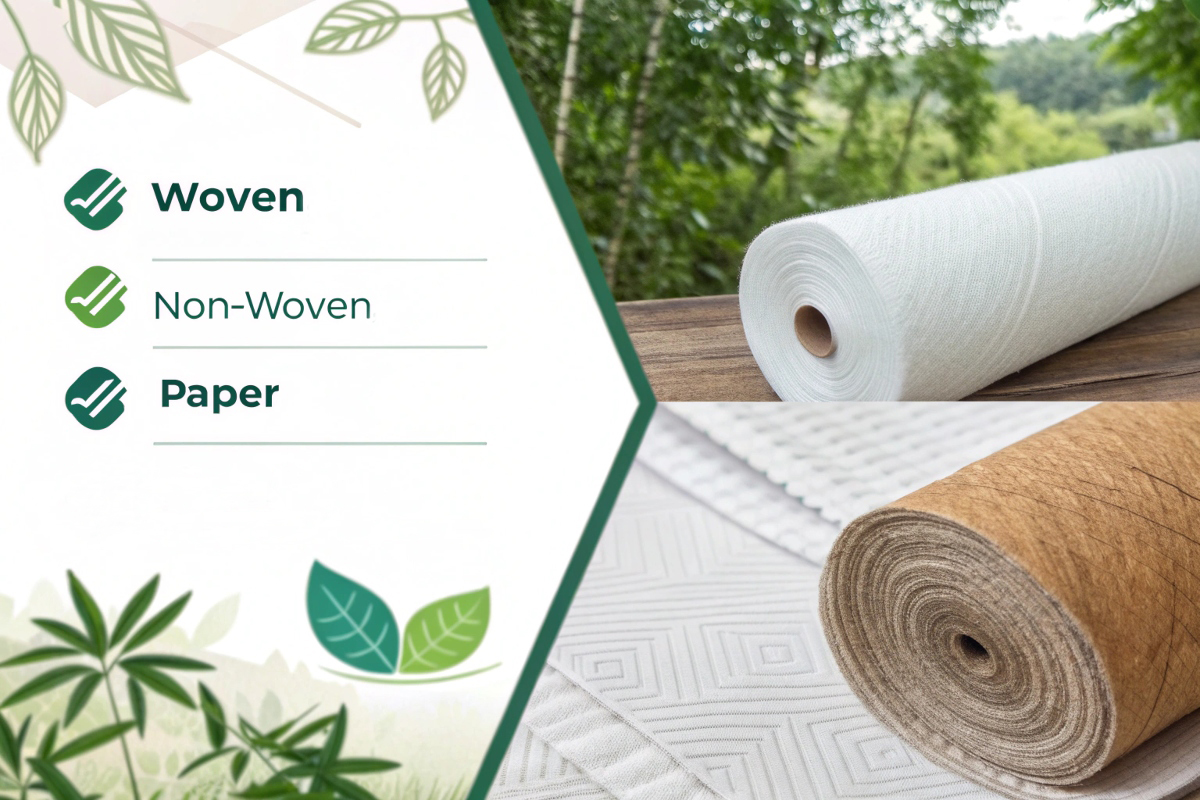
The differences between woven, non-woven, and paper materials4 often confuse even experienced professionals. That confusion usually stems from overlapping terms in marketing, evolving production technologies, and the fast-changing sustainability landscape. In this article, I’ll break it all down clearly, without jargon.
What separates woven, non-woven, and paper materials?
Most buyers struggle because these materials often look similar but behave very differently under stress.
Woven fabrics are made from interlaced yarns, non-wovens5 are bonded fibers, and paper comes from compressed pulped fibers. Their structure defines performance and suitability.
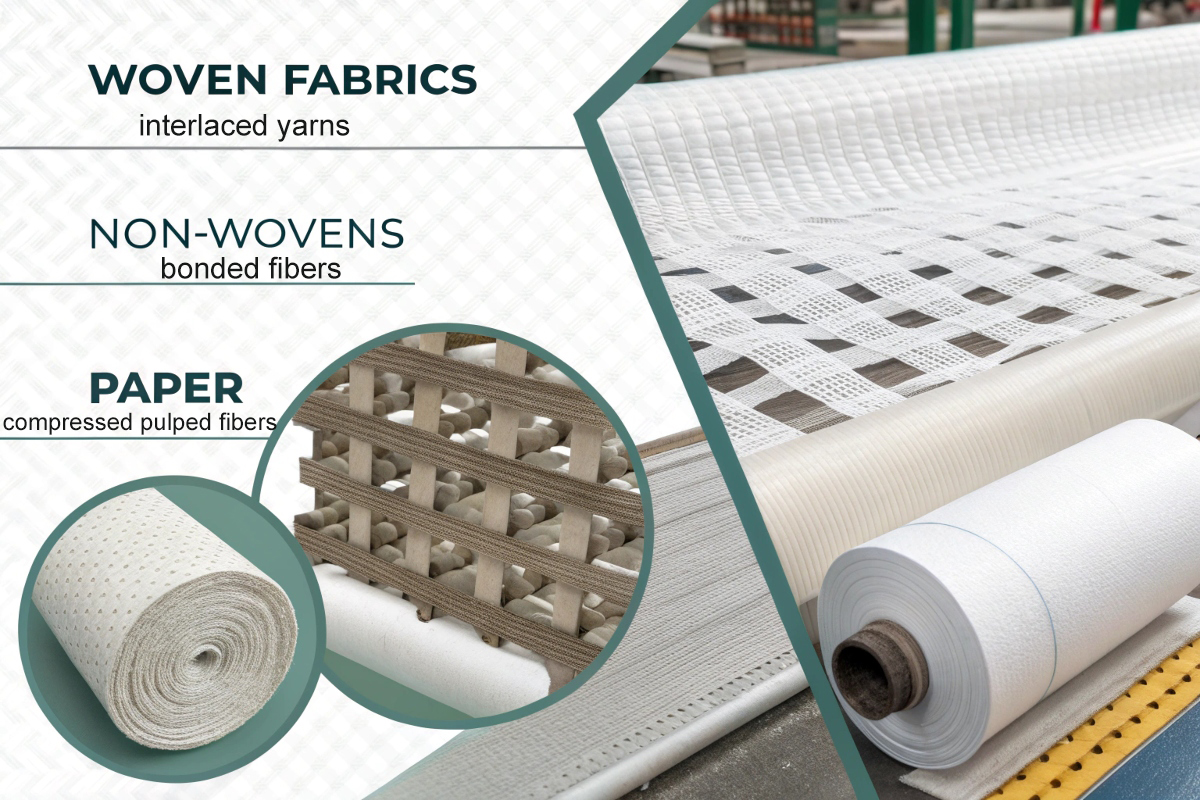
How is each material made?
Woven fabrics are created by weaving yarns through looms, a method that dates back centuries. Thread count and yarn type—natural or synthetic—impact strength and comfort. High thread count means higher durability but also higher cost.
Non-woven materials are formed without weaving or knitting. I usually work with spunbond or meltblown non-wovens in our factory. In spunbond, thermoplastic polymers like polypropylene are melted and extruded. In meltblown, the fibers are even finer, offering better filtration. Bonding can be thermal, mechanical, or chemical.
Paper production starts with wood pulp. The pulp is beaten, dried, and rolled using a calendaring process. Specialty types include kraft (for packaging), glassine (for food), and synthetic papers (for durability).
| Material | Process | Main Input | Machinery Used |
|---|---|---|---|
| Woven | Interlaced yarn weaving | Cotton, polyester | Looms, warping machines |
| Non-Woven | Fiber bonding (meltblown, spunbond) | Polypropylene, PET | Spunbond/meltblown lines |
| Paper | Pulping and calendaring | Wood pulp, recycled paper | Paper mills |
What performance differences really matter?
The wrong choice could mean customer complaints or failed quality audits.
Non-wovens are more porous and flexible, woven fabrics6 offer tensile strength, and paper provides low-cost rigidity—but weak moisture resistance.
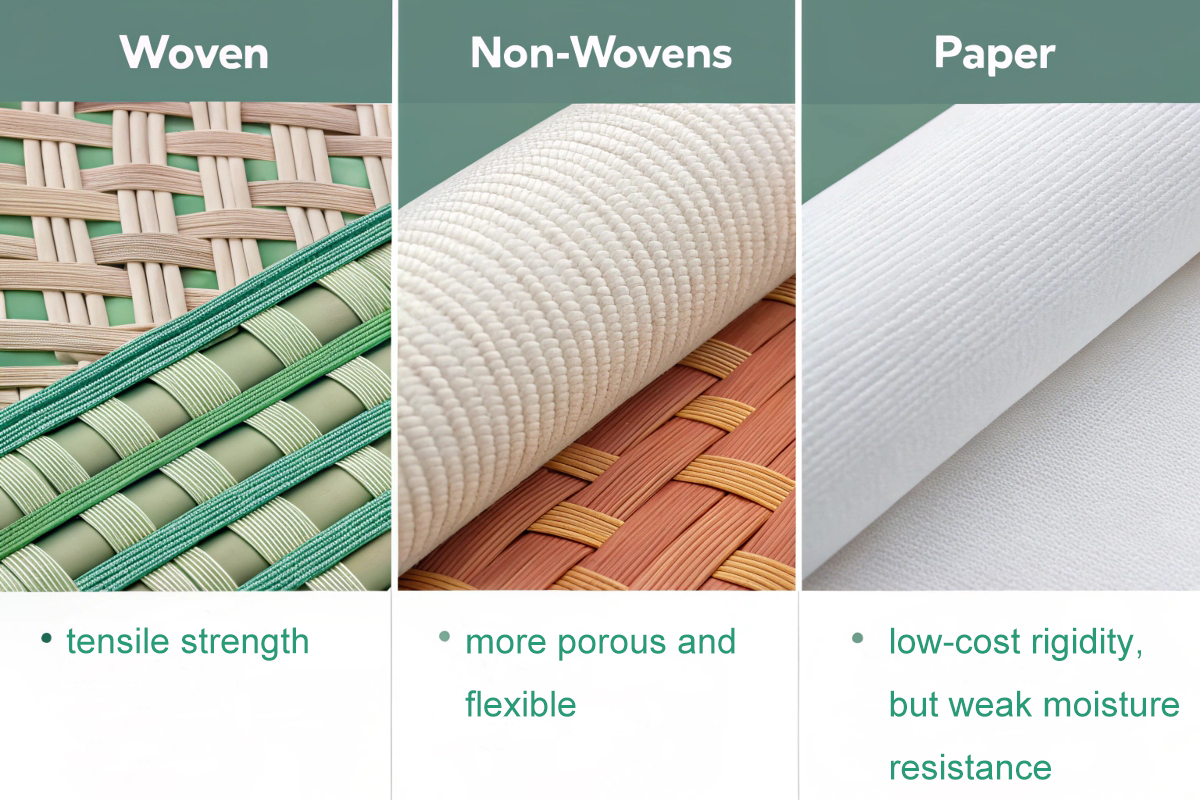
Material Properties
I regularly compare materials based on physical durability, resistance, and insulation when sourcing for new clients. Here’s what I’ve found:
| Property | Woven | Non-Woven | Paper |
|---|---|---|---|
| Tensile Strength | High | Medium | Low |
| Porosity | Low | High | Medium |
| Moisture Resistance7 | Medium | High (treated) | Low |
| Thermal Insulation8 | Medium | High (with layers) | Low |
| Acoustic Performance | Low | High | Low |
Chemical resistance9 is another big differentiator. Woven polyester resists solvents, non-wovens handle acids if coated, and most paper fails under liquid exposure. For insulation, I trust multilayered non-wovens for both heat and sound in industrial wipes.
Which industries use each material, and why?
Material performance must match industry needs—failure here means product returns and loss of trust.
Woven fabrics shine in geotextiles, non-wovens lead in hygiene and packaging, and paper still dominates in printing and food wraps.
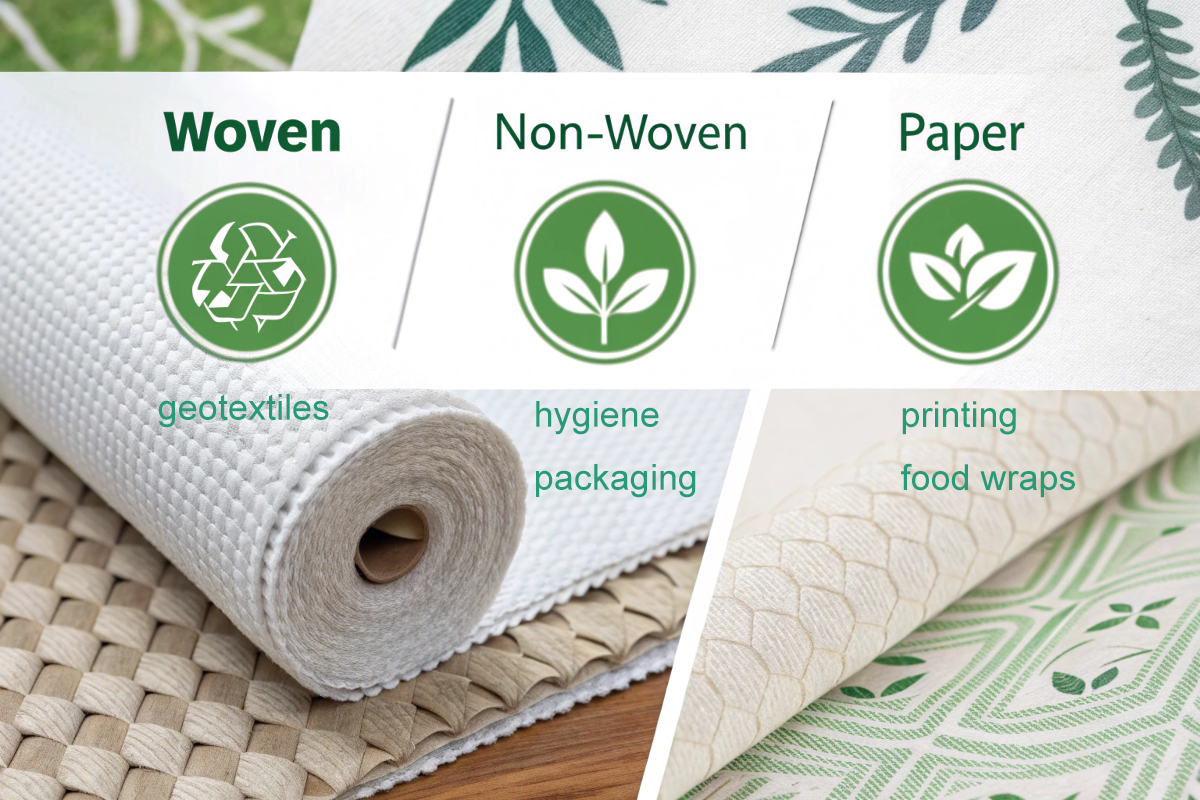
Applications
In the medical field, I often recommend non-wovens for their breathability and barrier properties. Surgical gowns made from SMS (spunbond-meltblown-spunbond) fabrics meet FDA standards for protection. On the other hand, patient chart papers are still paper-based, cheaper, but single-use.
Packaging is where things really get interesting. Our clients are shifting toward laminated paper10 and non-woven polypropylene for mailers. Moisture resistance and branding flexibility are top priorities. Laminated paper offers print quality but lacks stretch and tear resistance, unlike non-wovens.
Environmental projects also rely on all three. Woven geotextiles hold soil in place under highways. Non-woven erosion control fabrics biodegrade slowly and allow plant growth. Paper mats degrade fastest, but are prone to tear and water damage.
Which material is most sustainable?
Many buyers now ask me, “What’s the greenest option?”
Non-wovens can be recyclable or biodegradable11, papers are often compostable, and woven fabrics last longer—each with trade-offs in energy, water use, and biodegradability.
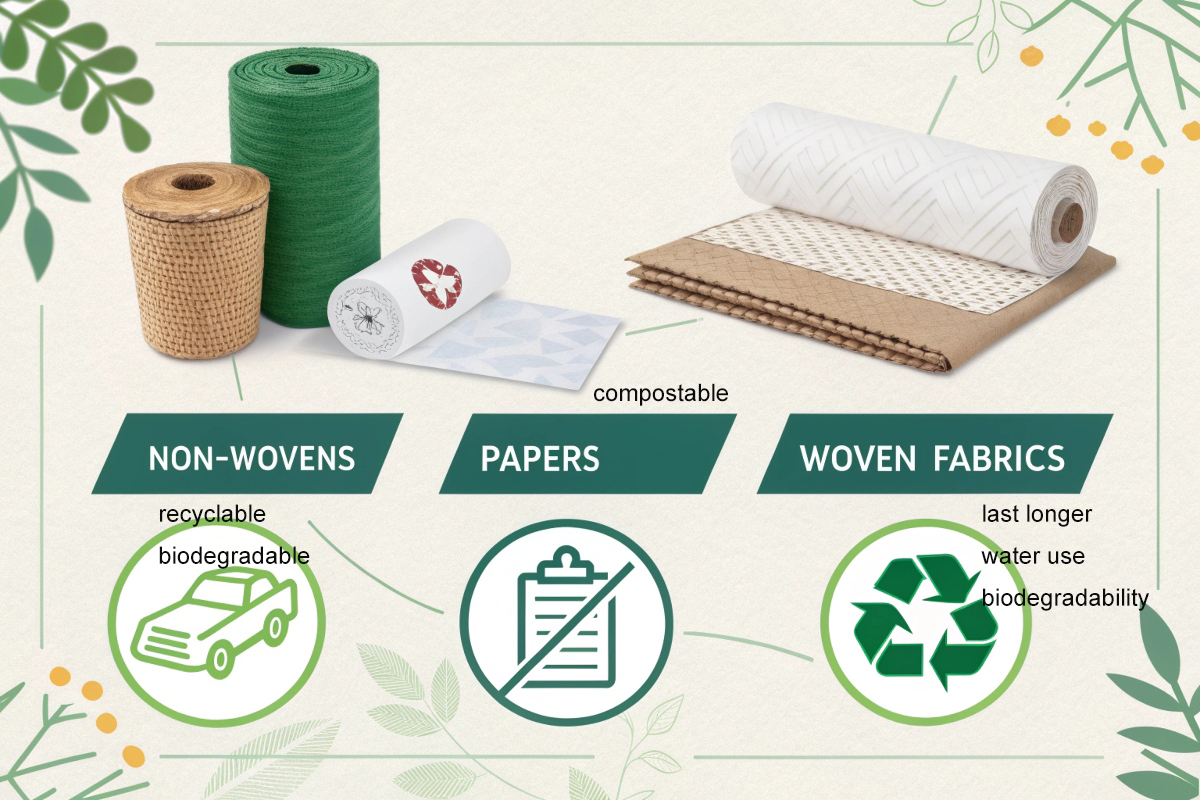
Environmental Impact
I’ve reviewed several LCAs (Life Cycle Assessments12) in the past year. Paper has high water and energy demands, but breaks down quickly. Non-wovens made from PLA (corn-based bioplastics) are compostable13. Hemp paper is gaining attention for its low pesticide requirement and renewability.
The biggest issue is recycling. Woven fabrics rarely get recycled unless upcycled into rags. Non-wovens can clog recycling systems14 unless separated. And paper, although recyclable, suffers from contamination—think greasy food wraps.
New tech is helping. PLA spunbond non-wovens and hemp-based papers are becoming viable. The key is in logistics and consumer behavior, not just material science.
| Material | Biodegradable | Recyclable | Water Use | Emerging Eco-Type |
|---|---|---|---|---|
| Woven | No | Limited | Medium | Bio-cotton blends |
| Non-Woven | Some | Hard to sort | Low | PLA, bamboo-based |
| Paper | Yes | Yes | High | Hemp composites |
Which material offers the best value?
The cheapest material isn’t always the best in the long run.
Paper is lowest in raw cost, woven fabrics last longest, but non-wovens balance cost and versatility—especially with automation.
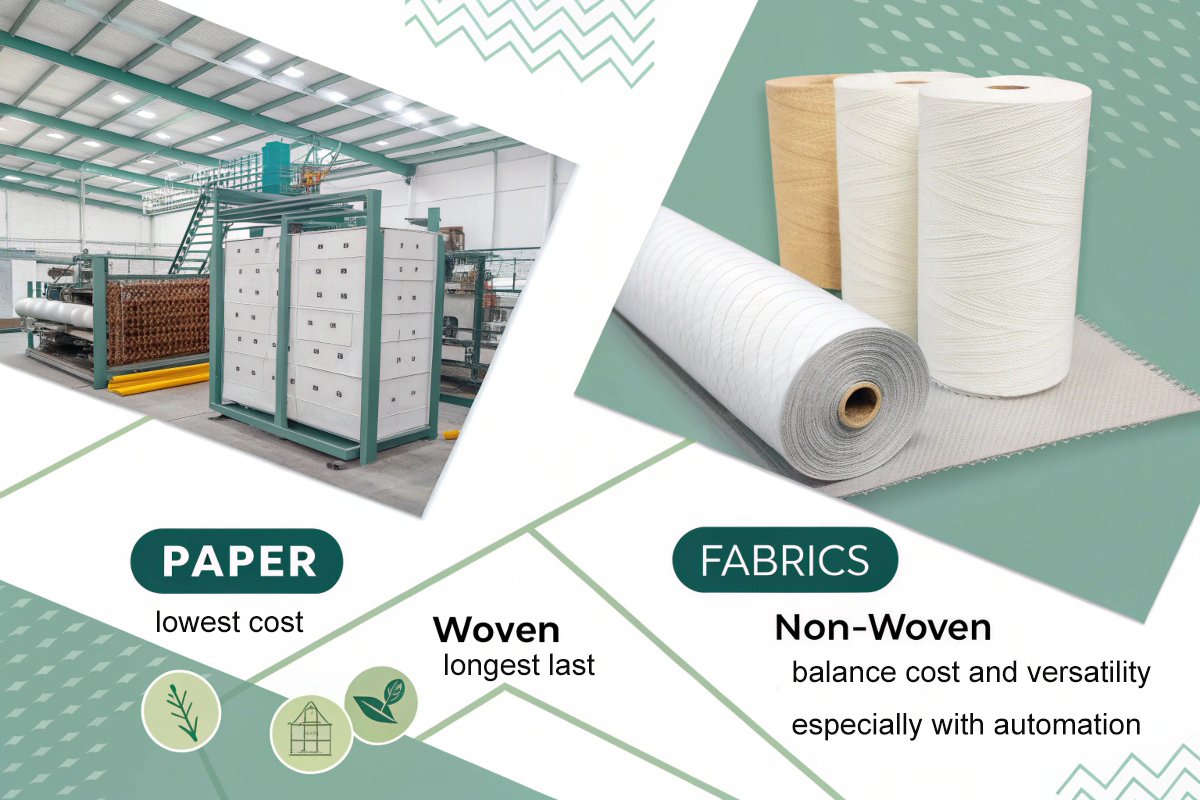
Cost Comparison
Between 2020 and 2024, paper pulp prices saw a 30% increase due to deforestation controls. Non-woven polypropylene remained stable due to global supply. Woven cotton costs spiked with harvest failures and energy prices.
Automation changes the game. Our factory runs 24/7 spunbond lines with minimal labor. Woven fabric production is more labor-heavy. Paper machines, while fast, lack versatility.
Cost of ownership matters. A durable microfiber towel (woven) may cost more upfront but last 50+ uses. A non-woven wipe is cheaper but single-use. If a client needs bulk, short-term usage—non-woven wins. For long-term reusability—go woven.
| Material | Raw Cost ($/kg) | Labor Need | Durability | Production Speed |
|---|---|---|---|---|
| Woven | 3.5 | High | High | Medium |
| Non-Woven | 2.0 | Low | Medium | High |
| Paper | 1.2 | Low | Low | Very High |
What’s next for these materials?
Smart buyers must adapt to changing materials and regulations quickly.
The future lies in conductive non-wovens15, stricter plastic bans, and nano-cellulose materials merging paper and textile tech.
Emerging Trends
Conductive non-wovens16 are already being tested for smart clothing and sensors. We’ve had inquiries from European buyers on this front. These fabrics integrate metal fibers for signal transmission while staying breathable.
Plastic bans17 are changing packaging standards. The EU and parts of Asia are phasing out single-use plastics, pushing clients toward bio-degradable non-wovens and laminated papers.
Nano-cellulose18 is the wild card. It’s made by breaking down wood fibers into microscopic chains—stronger than steel by weight. This tech could eventually replace both paper and synthetic textiles in certain fields.
I suggest buyers keep an eye on regulations and partner with material-savvy suppliers.
How should I choose the right material?
With so many options, choosing confidently needs a simple, guided process.
Use a 5-parameter flowchart to select materials and a supplier checklist to avoid sourcing mistakes.
Decision-Making Framework
Here’s how I help clients pick the best material:
Top 5 Parameters:
- Usage Environment (wet, dry, hot, cold)
- Required Durability19 (single or multi-use)
- Sustainability Goals20
- Branding Requirements
- Budget Constraints
Supplier Evaluation Checklist21:
- Does the supplier offer multiple material options?
- Are certifications like OEKO-TEX, FSC, ISO available?
- Do they provide material data sheets?
- Can they explain their production process?
- Are logistics and lead times clear?
Choosing the wrong supplier can mean delays, non-compliant goods, or even customs issues. A simple checklist often saves months of back-and-forth later.
Conclusion
Choosing between woven, non-woven, and paper materials depends on performance, cost, and sustainability—and getting it wrong can cost you more than just money.
Elbert Zhao
Founder, Elbert Wipes Solutions
📧[email protected] | 🌐 www.elbertwipes.com
8 production lines | 22 processing lines | OEKO-TEX certified | Walmart-approved supplier
-
Explore this link to gain a deeper understanding of the unique properties and applications of these materials, aiding in informed sourcing decisions. ↩
-
This resource will provide insights into the sustainability aspects of various materials, crucial for making eco-friendly choices in sourcing. ↩
-
Understanding the key factors in sourcing decisions can enhance your purchasing strategy and improve overall business outcomes. ↩
-
Learn about various paper materials and their applications, which can help in choosing the right type for your needs. ↩
-
Discover the manufacturing process and benefits of non-woven materials, crucial for informed material selection. ↩
-
Explore the intricacies of woven fabrics, their production methods, and how they differ from other materials for a deeper understanding. ↩
-
Understanding moisture resistance can help you choose the right materials for your projects, ensuring durability and performance. ↩
-
Exploring thermal insulation can enhance your knowledge of energy efficiency and comfort in building materials. ↩
-
Learning about chemical resistance is crucial for selecting materials that withstand harsh environments and maintain integrity. ↩
-
Discover the benefits of laminated paper in packaging, including print quality and moisture resistance, crucial for branding. ↩
-
Learn about biodegradable materials and their role in sustainability, helping you make eco-friendly choices. ↩
-
Understanding LCAs can provide insights into the environmental impacts of various materials, helping you make informed choices. ↩
-
Exploring compostability can reveal how materials like PLA contribute to reducing waste and promoting sustainability. ↩
-
Learning about recycling systems can help you understand the complexities of waste management and the importance of proper sorting. ↩
-
Discover the innovative uses of conductive non-wovens in technology and textiles, shaping the future of material science. ↩
-
Explore how conductive non-wovens are revolutionizing smart clothing and sensor technology, enhancing functionality and comfort. ↩
-
Learn about the impact of plastic bans on packaging standards and how businesses are adapting to sustainable practices. ↩
-
Discover the potential of nano-cellulose in replacing traditional materials, offering strength and sustainability in textiles. ↩
-
Learn about assessing material durability to ensure your products meet performance standards and customer expectations effectively. ↩
-
Explore this resource to understand how to align your material choices with sustainability objectives, enhancing your brand’s eco-friendliness. ↩
-
This link will provide insights into creating a comprehensive supplier evaluation checklist, ensuring you choose the right partners for your materials. ↩

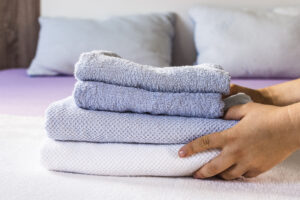




18 Responses
Have you ever considered about including a little bit more than just your articles? I mean, what you say is fundamental and everything. But just imagine if you added some great pictures or video clips to give your posts more, “pop”! Your content is excellent but with pics and clips, this site could undeniably be one of the greatest in its field. Great blog!
Thanks for your reminding!
I would also love to add that in case you do not now have an insurance policy or maybe you do not participate in any group insurance, you will well gain from seeking the assistance of a health insurance agent. Self-employed or those that have medical conditions usually seek the help of any health insurance broker. Thanks for your text.
Thanks
I got what you mean ,saved to fav, very decent website .
Thanks
Je recommande vivement Ernestopro.fr pour choisir le matériel adapté à vos besoins, notamment dans le domaine des lingettes et des textiles pour le nettoyage. Leur expertise et leur large gamme de produits garantissent des solutions performantes, durables et économiques. Grâce à Ernestopro.fr, j’ai trouvé des matériaux de qualité qui répondent parfaitement à mes exigences professionnelles tout en étant respectueux de l’environnement. N’hésitez pas à consulter leur site pour découvrir leurs offres et conseils spécialisés, cela vous permettra de faire un choix éclairé en toute confiance.
Thanks a lot!
Jusst desire to say your article is as surprising.
The clearness for your post is just cool and i could suppose you’re
knowledgeable on this subject. Well along with your permission allow
me to snatch your feed to keep updated with drawing close post.
Thanks one million and please keep up the enjoyable work.
Appreciate you like it, we have been in cleaning products catagory production since 1987. We will keep posting more valuable articles.
You’re so interesting! I do not think I have read through something like that before.
So wonderful to discover another person with some unique thoughts on this issue.
Seriously.. many thanks for starting this up. This web site is something
that is required on the web, someone with a bit of originality!
Appreciate you like it, we will keep posting with depth!
I loved as much as you’ll receive carried out right here.
The sketch is attractive, your authored material stylish.
nonetheless, you command get bought an nervousness
over that you wish be delivering the following. unwell
unquestionably come more formerly again as exactly the same
nearly very often inside case you shield this hike.
Appreciate you like it, we will keep posting high-level blogs!
If some one desires expert view about blogging and site-building afterward i propose him/her
to visit this web site, Keep up the good work.
Thanks!
This is the right blog for anybody who wishes to find out about this topic.
You know so much its almost hard to argue with you (not
that I really will need to…HaHa). You certainly put a brand
new spin on a subject that’s been discussed for ages.
Wonderful stuff, just excellent!
Appreciate you like it!